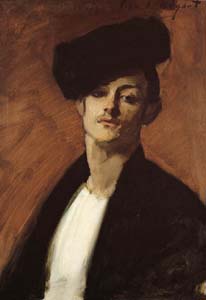Albert de Belleroche
11:50 PM |
| John Singer Sargent. Albert de Belleroche. 1883. |
 |
| John Singer Sargent. Head in Profile of a Young Man. 1883. |
The two quickly began friends, sharing a studio space in Paris where they sketched and painted each other. Sargent painted Belleroche in more thirty works of various poses and costumes, ranging from a medieval courtier to a Spanish aristocrat. Even when Sargent focused on his masterpiece of Madame Gautreau, he was thinking about Belleroche. Sargent’s drawing, most commonly thought of as a sketch for Madame Gautreau Drinking a Toast, has been proposed by art historians that Sargent merged Madame Gautreau and Belleruche into one image. The “brooding and romantic quality” in these works, argues Deborah Davis, suggests a relationship went beyond friendship or mentorship.
Sargent had started to draw Amelie but transformed her into Belleroche, an indication of his emotional confusion in that summer of 1883. Some even go as far to say only when Sargent confirmed his desire towards Belleroche had he lifted his artist’s block and allowed himself to concentrate on Madame Gautreau. Could the peripatetic lifestyle and loneliness in Sargent’s early life make him afraid of “otherness?” After all, as an expatriate, otherness was a feeling Sargent knew all too well. Other than his works, however, there is little evidence about the artist’s private life. But if he was gay, does it matter? On the bright side, this speculation gives Sargent scholarship a new direction. Until recently, Sargent was seen as a slick, superficial society painter. Discussions about his sexuality, whether relevant to the art, forces people think about implications of sexuality.
0 comments